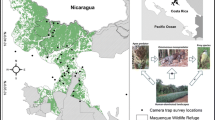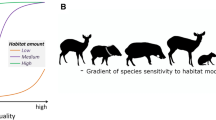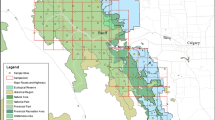Abstract
Studies on the distribution of mammalian carnivores in fragmented landscapes have focused mainly on structural aspects such as patch and landscape features; similarly, habitat connectivity is usually associated with landscape structure. The influence of food resources on carnivore patch use and the important effect on habitat connectivity have been overlooked. The aim of this study is to evaluate the relative importance of food resources on patch use patterns and to test if food availability can overcome structural constraints on patch use. We carried out a patch-use survey of two carnivores: the beech marten (Martes foina) and the badger (Meles meles) in a sample of 39 woodland patches in a fragmented landscape in central Italy. We used the logistic model to investigate the relative effects on carnivore distribution of patch, patch neighbourhood and landscape scale variables as well as the relative abundance of food resources. Our results show how carnivore movements in fragmented landscapes are determined not only by patch/landscape structure but also by the relative abundance of food resources. The important take-home message of our research is that, within certain structural limits (e.g. within certain limits of patch isolation), by modifying the relative amount of resources and their distribution, it is possible to increase suitability in smaller/relatively isolated patches. Conversely, however, there are certain thresholds above which an increase in resources will not achieve high probability of presence. Our findings have important and generalizable consequences for highly fragmented landscapes in areas where it may not be possible to increase patch sizes and/or reduce isolation so, for instance, forest regimes that will increase resource availability could be implemented.




Similar content being viewed by others
References
Arrigoni PV (1998) La vegetazione forestale: foreste e macchie della Toscana. Edizioni regione Toscana, Firenze, 1–270
Bani L, Baietto M, Bottoni L, Massa R (2002) The use of focal species in designing a habitat network for a lowland area of Lombardy Italy. Conserv Biol 16:826–831
Barea-Azcón JM, Virgós E, Ballesteros-Duperón E, Moleón M, Chirosa M (2007) Surveying carnivores at large spatial scales: a comparison of four broad-applied methods. Biodiversity Conserv 16:1213–1230
Bender DJ, Tischendorf L, Fahrig L (2003) Using patch isolation metrics to predict animal movement in binary landscapes. Landscape Ecol 18:17–39
Burnham KP, Anderson DR (2002) Model selection and inference––a practical information––theoretic approach, 2nd edn. Springer-Verlag, New York
Butterfield J, Coulson JC, Wanless S (1981) Studies on the distribution food breeding biology and relative abundance of the pigmy common shrews (Sorex minutus and Sorex araneus) in upland areas of northern England. J Zool (London) 195:169–180
Carroll C, Noss RF, Paquet PC (2001) Carnivores as focal species for conservation planning in the Rocky Mountain region. Ecol Appli 11:961–980
Churchfield S (1990) The natural history of Shrews C Helm/A and C Black London, pp 1–178
Churchfield S, Rychlik L (2006) Diet and coexistence in Neomys and Sorex shrews in Bialowieza forest eastern Poland. J Zool (London) 269:381–390
Clevenger AP (1994) Feeding ecology of Eurasian pine martens and stone martens in Europe. In: Buskirk SW, Harestad AS, Raphael MG, Powell RA (eds) Martens, sables and fishers, Cornell University Press, Ithaca, pp 326–340
Crooks KR, Soulè ME (1999) Mesopredators release and avifaunal extinctions in a fragmented system. Nature 400:563–566
Crooks KR (2002) Relative sensitivities of mammalian carnivores to habitat fragmentation. Conserv Biol 16:488–502
Fahrig L (2003) Effects of habitat fragmentation on biodiversity. Annu Rev Ecol Syst 34:487–515
Fleishman E, Ray C, Sjögren-Gulve P, Boggs CL, Murphy DD (2002) Assessing the roles of patch quality, area, and isolation in predicting metapopulation dynamics conservation biology 16:706–713
Fischer J, Lindenmayer DB (2007) Landscape modification and habitat fragmentation: a synthesis. Global Ecol Biogeogr 16:265–280
Foley JA, DeFries R, Asner GP, Barford C, Bonan G, Carpenter SR, Chapin FS, Coe MT, Daily GC, Gibbs HK, Helkowski JH, Holloway T, Howard EA, Kucharik CJ, Monfreda C, Patz JA, Prentice IC, Ramankutty N, Snyder PK (2005) Global consequences of land use. Science 309:570–574
Forman RTT (1995) Land mosaics. The ecology of landscapes and regions. Cambridge University Press
Freckleton RP (2002) On the misuse of residuals in ecology: regression of residuals vs multiple regression. J Anim Ecol 71:542–545
Genovesi P (1993) Strategie di sfruttamento delle risorse e struttura sociale della faina (Martes foina Erxleben 1777) in ambiente forestale e rurale. PhD Dissertation, University “La Sapienza” of Rome
Genovesi P (2003) Faina (Martes foina) In: Boitani L, Lovari S, Vigna-Taglianti A (eds) Fauna d’Italia Mammalia: Carnivora Artiodactyla. Calderini, Bologna, pp 113–123
Genovesi P, De Marinis AM (2003) Tasso (Meles meles) In: Boitani L, Lovari S, Vigna-Taglianti A (eds) Fauna d’Italia Mammalia: Carnivora Artiodactyla. Calderini, Bologna, pp 159–167
Guevara S, Laborde J, Sanchez G (1998) Are isolated remnant trees in pastures a fragmented canopy? Selbyana 19:34–43
Hargis CD, Bissonette JA, David JL (1998) The behavior of landscape metrics commonly used in the study of habitat fragmentation. Landsc Ecol 13:167–186
Henle K, Davies KF, Kleyer M, Margules C, Settele J (2004) Predictors of species sensitivity to fragmentation. Biodiversity Conserv 13:207–251
Herrmann M (1994) Habitat use and spatial organization by the stone marten. In: Buskirk SW, Harestad AS, Raphael MG, Powell RA (Eds) Martens, sables and fishers, Cornell University Press, Ithaca, pp 122–136
Holland GJ, Bennett AF (2007) Occurrence of small mammals in a fragmented landscape: The role of vegetation heterogeneity. Wildl Res 34:387–397
Holling CS (1955) The components of predation as revealed by a study of the small mammal predation of European sawfly. Can Entomol 91:293–332
Hosmer DW, Lemeshow S (2000) Applied logistic regression, 2nd edn. John Wiley and Sons, USA
Hunter RD, Fisher RN, Crooks KC (2003) Landscape-level connectivity in Coastal Southern California Usa as assessed through Carnivore Habitat Suitability. Nat Area J 23:302–314
Innes DGL, Bendell JF, Naylor BJ, Smith BA (1990) High density of the masked shrew Sorex cinereus in jack pine plantations in northern Ontario. Am Midl Nat 124:330–341
Jenness J (2003) Identify features within distance (id_within_distavx) extension for ArcView 3x v 1b Jenness Enterprises http://www.jennessentcom/downloads/id_within_distzip
Koper N, Schmiegelow FKA, Merril EH (2007) Residuals cannot distinguish between ecological effects of habitat amount and fragmentation: implications for the debate. Landsc Ecol 22:811–820
Kramer-Schadt S, Revilla E, Wiegand T , Breitenmoser U (2004) Fragmented landscapes road mortality and patch connectivity: modelling influences on the dispersal of the Eurasian lynx. J Appl Ecol 41:711–723
Lichstein JW, Simons TR, Shriner SA, Franzreb KE (2002) Spatial autocorrelation and autoregressive models in ecology. Ecol Monogr 72:445–463
Lima SL, Zollner PA (1996) Towards a behavioural ecology of ecological landscapes. Trends Ecol Evol 11:131–135
Lindenmayer DB, Fischer J (2006) Habitat fragmentation and landscape change: an ecological and conservation synthesis. Island Press, Washington DC, pp 1–328
Luck GW, Daily GC (2003) Tropical countryside bird assemblages: richness composition and foraging differ by landscape context. Ecol Appli 13:235–247
Macdonald DW (1983) The ecology of carnivore social behaviour. Nature 301:379–384
MacKenzie DI, Nichols JD, Lachman GB, Droege S, Royle JA, Langtimm CA (2002) Estimating site occupancy when detection probability is less than one. Ecology 83:2248–2555
McGarigal K, McComb WC (1995) Relationships between landscape structure and breeding birds in the Oregon Coast Range. Ecol Monogr 65:215–260
McGarigal K, Cushman S (2002) Comparative evaluation of experimental approaches to the study of habitat fragmentation. Ecol Appli 12:335–345
Melis C, Cagnacci F, Bargagli L (2002) Food habits of the Eurasian badger in a rural Mediterranean area. Z Jagdwiss 48:236–246
Mortelliti A, Boitani L (2007a) Evaluation of scent-stations surveys to monitor the distribution of three european carnivore species (Martes foina, Meles meles, Vulpes vulpes) in a fragmented landscape. Mamm Biol (in press, doi 101016/jmambio200703001)
Mortelliti A, Boitani L (2007b) Estimating species’ absence colonization and local extinction in patchy landscapes: an application of occupancy models with rodents. J Zool 273:244–248
Mortelliti A, Amori G, Sammuri G, Boitani L (2007) Factors affecting the distribution of Sorex samniticus and endemic Italian shrew in an heterogeneous landscape. Acta Theriol 52:75–84
Paquet PC, Alexander SM, Swan PL, Darimont C (2006) Influence of natural fragmentation and resource availability on distribution and connectivity of gray wolves (Canis lupus) in the archipelago of coastal British Columbia Canada. In: Crooks KR, Sanjayan M (eds) Connectivity conservation. Cambridge University Press, Cambridge, pp 130–156
Platt WJ, Blakley NR (1973) Short term effects of shrew predation upon invertebrate prey sets in prairie ecosystems. Proc Iowa Acad Sci 80:60–66
Rangel TFLVB, Diniz-Filho JAF, Bini LM (2006) Towards an integrated computational tool for spatial analysis in macroecology and biogeography. Global Ecol and Biogeogr 15:321–327
Revilla E (2003) What does the resource dispersion hypothesis explain if anything? Oikos 101:428–432
Rodriguez A Martin R, Delibes M (1996) Space use and activity in a mediterranean population of badgers (Meles meles). Acta Theriol 41:59–72
Rondinini C, Boitani L (2002) Habitat use by beech martens in a fragmented landscape. Ecography 25:257–264
Sadlier LMJ, Webbon CC, Baker PJ, Harris S (2004) Methods of monitoring Foxes (Vulpes vulpes) and Badgers (Meles meles): are field signs the answer? Mammal Rev 34:75–98
Santillo DJ, Leslie DM, Brown PW (1989) Responses of Small Mammals and Habitat to Glyphosate Application on Clearcuts. J Wildl Manage 53:164–172
Santos T, Telleria JL, Virgós E (1999) Dispersal of Spanish Juniper Juniperus thurifera by birds and mammals in a fragmented landscape. Ecography 22:193–204
Schooley RL, Wiens JA (2003) Finding habitat patches and directional connectivity. Oikos 102:559–570
Serafini P, Lovari S (1993) Food habits and trophic niche overlap of the red fox and the stone marten in a Mediterranean rural area. Acta Theriol 38:233–244
Stephens DW, Krebs JR (1986) Foraging Theory. Princeton University Press, Princeton
Swihart RK, Gehring TM, Kolozsvary MB, Nupp TE (2003) Responses of “resistant” vertebrates to habitat loss and fragmentation: the importance of niche breadth and range boundaries. Diver Distrib 9:1–8
Taylor PD, Fahrig L, Henein K, Merriam G (1993) Connectivity is a vital element of landscape structure. Oikos 68:571–572
Taylor PD, Fahrig L, With KA (2006) Landscape connectivity: a return to the basics. In: Crooks KR, Sanjayan M (eds) Connectivity conservation. Cambridge University Press, Cambridge, pp 29–43
Tuyttens FAM, Long B, Fawcett T, Skinner A, Brown JA, Cheeseman CL, Roddam AW, MacDonald DW (2001) Estimating group size and population density of Eurasian Badgers Meles meles by quantifying latrine use. J Appl Ecol 38:1114–1121
Wilson GJ, Delahay RJ (2001) A review of methods to estimate the abundance of terrestrial carnivores using field signs and observation. Wildl Res 28:151–164
With KA, Crist TO (1995) Critical thresholds in responses to landscape structure. Ecology 76:2446–2459
Van Apeldoorn RC, Knaapen JP, Schippers P, Verboom J, Van Engen H, Meeuwsen H (1998) Applying ecological knowledge in landscape planning: a simulation model as a tool to evaluate scenarios for the badger in the Netherlands. Landsc Urban Plan 41:57–69
Virgós E (2001) Role of isolation and habitat quality in shaping species abundance: a test with badgers (Meles meles L) in a gradient of forest fragmentation. J Biogeogr 28:381–389
Virgós E, Garcia FJ (2002) Patch occupancy by stone martens (Martes foina) in fragmented landscapes of central Spain: the role of fragment size isolation and habitat structure. Acta Oecol 23:231–237
Virgós E, Tellería Jd, Santos T (2002) A comparison on the response to forest fragmentation by medium-sized Iberian carnivores in central Spain. Biodivers Conserv 11:1063–1079
Zielinski WJ, Stauffer HB (1996) Monitoring Martes populations in California: survey design and power analysis. Ecol Appli 6:1254–1267
Zollner PA, Lima SL (1999) Illumination and perception of remote habitat patches by white-footed mice. Anim Behav 58:489–500
Acknowledgements
This study was funded by the Province of Siena “Ufficio Risorse Faunistiche e Riserve Naturali”. Thanks to Giulia Santulli Sanzo for help during fieldwork and to Carlo Rondinini and Domitilla Nonis for suggestions on the manuscript. Thanks to Joyce Keep and Daniel Whitmore for language revision.
Author information
Authors and Affiliations
Corresponding author
Electronic supplementary material
Below is the link to the electronic supplementary material.
Appendices
Appendix 1 Carnivore distribution and patch characteristics
Summary of the distribution of beech marten and badger in the sampled patches, including patch size and one measurement of patch isolation (proximity index, threshold 1,000 m). 0 = not found, 1 = detected. Scent-stations were used only for sites 1–26. Patch location (by ID in first column) is shown in Fig. 1
Patch ID | Hectares | Proximity index (1,000 m) | PCA component (1,000 m) factor scores | Beech marten (Martes foina) | Badger (Meles meles) |
|---|---|---|---|---|---|
1 | 0.48 | 0.12 | −0.45 | 0 | 0 |
2 | 0.41 | 0.23 | −0.41 | 0 | 0 |
3 | 1.38 | 0.24 | −0.31 | 0 | 1 |
4 | 1.32 | 0.01 | −0.58 | 0 | 0 |
5 | 1.53 | 0.00 | −0.79 | 0 | 0 |
6 | 0.85 | 0.58 | −0.33 | 0 | 0 |
7 | 1.15 | 0.51 | −0.25 | 0 | 0 |
8 | 1.80 | 0.21 | −0.29 | 0 | 1 |
9 | 2.20 | 0.01 | −0.52 | 0 | 0 |
10 | 2.24 | 0.00 | −0.59 | 0 | 0 |
11 | 2.22 | 0.14 | −0.33 | 0 | 0 |
12 | 2.15 | 0.36 | −0.30 | 0 | 0 |
13 | 4.51 | 0.14 | −0.28 | 1 | 0 |
14 | 3.86 | 0.15 | −0.27 | 1 | 0 |
15 | 5.09 | 0.15 | −0.28 | 0 | 1 |
16 | 3.56 | 0.07 | −0.35 | 0 | 0 |
17 | 6.37 | 0.02 | −0.34 | 1 | 0 |
18 | 8.59 | 0.25 | −0.15 | 1 | 1 |
19 | 8.17 | 0.08 | −0.27 | 0 | 0 |
20 | 15.65 | 0.91 | −0.04 | 1 | 1 |
21 | 14.79 | 0.94 | −0.05 | 1 | 1 |
22 | 20.85 | 1.28 | −0.01 | 1 | 1 |
23 | 27.27 | 0.13 | −0.10 | 1 | 1 |
24 | 53.00 | 4.92 | 0.37 | 1 | 1 |
25 | 65.56 | 29.22 | 0.61 | 1 | 1 |
26 | 79.86 | 0.21 | −0.01 | 1 | 1 |
27 | 30,000 | 30.00 | 3.33 | 1 | 1 |
28 | 0.32 | 1.17 | −0.31 | 0 | 0 |
29 | 1.07 | 0.05 | −0.46 | 0 | 0 |
30 | 1.39 | 0.00 | −0.63 | 0 | 0 |
31 | 2.43 | 0.11 | −0.33 | 0 | 0 |
32 | 2.52 | 0.03 | −0.51 | 0 | 0 |
33 | 3.00 | 0.06 | −0.38 | 0 | 1 |
34 | 4.43 | 0.30 | −0.21 | 1 | 0 |
35 | 7.72 | 0.00 | −0.58 | 0 | 1 |
36 | 8.16 | 0.86 | −0.13 | 1 | 1 |
37 | 101.72 | 2.44 | 0.13 | 1 | 1 |
38 | 8000 | 30.00 | 3.22 | 1 | 1 |
39 | 27,500 | 30.00 | 3.32 | 1 | 1 |
Appendix 2 Covariates
List of covariates used as predictor variables for the logistic regression models. Covariates are patch attributes measured in a sample of 39 patches in the Province of Siena, central Italy
Covariate types | List of covariates |
|---|---|
Patch geometry (variables measured in metres or hectares and log-transformed) | Patch size; patch shape (Area/perimeter); average edge distance (in metres) of patches within 1000 m (dist_1000), sum of the areas of the patches within 1000 (sum_1000); proximity index (PI_1000); Mean Proximity Index (MPI_1000); distance to nearest farm; distance to nearest non-fragmented area |
Resource availability/abundance (shrub cover was estimated according to Braun-Blanquet classes) | Apodemus sp abundance index, insectivore abundance, fruit (shrubs and Juniperus sp) |
Patch and neighborhood PCA factor (1000 m) (factor loadings in brackets) | Log_ha (0.924); sum_1000 (0.809); dist_1000 (−0.961); PI_1000 (0.916); MPI_1000 (0.972) |
Landscape scale variables | Residual habitat cover (class area), edge density, mean shape index, median patch size |
Rights and permissions
About this article
Cite this article
Mortelliti, A., Boitani, L. Interaction of food resources and landscape structure in determining the probability of patch use by carnivores in fragmented landscapes. Landscape Ecol 23, 285–298 (2008). https://doi.org/10.1007/s10980-007-9182-7
Received:
Accepted:
Published:
Issue Date:
DOI: https://doi.org/10.1007/s10980-007-9182-7




